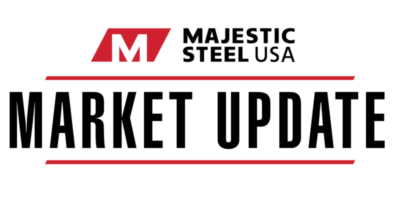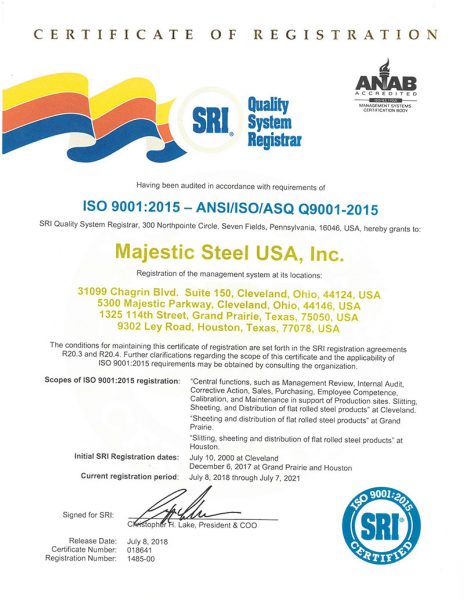Market Update | September 21, 2022
ARCHITECTURE FIRM ACTIVITY EXPANDING FAST
The August Architecture Billings Index came in at 53.3, up from 51.0 in July. The ABI has been in expansion for nineteen consecutive months. The new projects inquiry index increased as well, climbing to 57.9 from 56.1 previously. Regionally, three of the four regions showed expansion, with only the Northeast seeing a slight decline.
Input Costs
The recent up and down movement for zinc subsided this week, as pricing dipped slightly from last week.
-
-
Zinc pricing came in at $1.42/lb this week, remaining below $1.50/lb for the third straight week.
-
Spot iron ore pricing declined this week, sliding for the second consecutive week and is below $100/mt for the first time in over a month.
-
-
Spot iron ore pricing is currently at $96.65/mt, down 7.3% from the end of last week and is down 4.0/mt on a m/m basis.
-
Pacific Basin met coal pricing declined slightly this week, sliding to $256.50/mt.
-
-
Current pricing is down 5.5% from the end of last week and down 5.4% from this time last month.
-
Supply
Domestic raw steel production dropped sharply last week, sliding to its lowest level since the first week of January 2021.
-
- U.S. steelmakers produced 1.694 million tons at an 76.9% utilization rate.
- YTD production is now down 3.9% from the same time last year.
Based on preliminary import licenses, the daily average for September (19 days) is down 11.9% from the daily rate in August.
-
- Excluding volatile slab imports, the daily average is down 14.3% from August.
U.S. Steel announced late last week that they have idled the #8 furnace at their Gary works facility.
-
- They noted market conditions and high import levels for their reasons for idling the furnace.
- The #8 furnace has a daily capacity of 3,000 tons (~1.1 million tons annually).
DEMAND
Confidence among U.S. homebuilders declined at a faster rate in September and is now negative for the second consecutive month.
-
-
The September Housing Market Index came in at 46, down from 49 in August and is at its lowest level since May 2020.
-
Any reading below 50 denotes a contraction in confidence, while a reading above 50 indicates optimism.
- While the present situation component slowed slightly to 54.0, it was the only one to remain above 50.0.
- Both the next six months and traffic components grew deeper into the negative by sliding to 46 and 31, respectively.
- Rising mortgage rates, higher building material costs, and the continued strain on labor are all negatively impacting homebuilder confidence as we are moving into Q4.
-
After sliding sharply in two of the previous three months, new housing starts increased sharply in August.
-
-
August new housing starts increased to a 1.575 million-unit rate, up 12.2% from July but still down slightly from the 1.576 million unit rate in August 2021.
-
This is the fourth consecutive month in which starts were down on a year-over-year basis.
- The pickup in starts in August mostly came from multi-family units, which accounted for 40.6% of total starts in August.
- Year-to-date actual starts are now up 2.7% compared to the same timeframe last year.
- Permits, an indicator for future construction, were down sharply in August, sliding to a 1.517 million-unit rate.
- This is down 10.0% from July and down 14.4% from August 2021.
-
Activity at the architecture firm level expanded at a faster rate in August compared to the expansion seen in July.
-
-
The August Architecture Billings Index came in at 53.3, up from 51.0 in July but is down from the 55.6 reading in August 2021.
-
The ABI has been in expansion for nineteen consecutive months.
- Any reading over 50.0 indicates an expansion in activity, while any reading below 50.0 denotes a contraction.
- The new projects inquiry index increased as well, climbing to 57.9 from 56.1 previously.
- Regionally, three of the four regions showed expansion, with only the Northeast (49.8) seeing a slight decline.
- The sector breakdown showed all four sectors expanding in August, with the multifamily (52.0) and institutional sectors (52.0) coming in the strongest.
-
U.S. light vehicle production increased sharply in August after the seasonally impacted low total in July.
-
-
August light vehicle production totaled 982,161 units, up 52.4% from July and was up a sharp 27.8% from 768,688 units in August 2021.
-
This is the highest monthly production total since October 2018.
- Production increased equally for cars and light trucks, each climbing 52% from July.
- Light truck production totaled 804,527 units, the highest total in twenty years.
- Year-to-date light vehicle production is now up 7.8% from the same timeframe last year.
-
This material, information and analyses (the “Content”) may include certain statements, estimates and projections prepared with respect to, among other things, historical data and anticipated performance. Content may reflect various assumptions by Majestic Steel USA, Inc. concerning anticipated results that are inherently subject to significant economic, competitive and other uncertainties and contingencies and have been included for illustrative purposes. Content is provided AS-IS.

